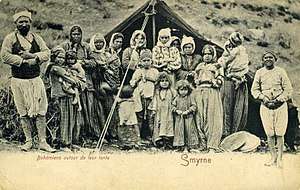Romani people in Turkey
| Total population | |
|---|---|
| Estimates vary | |
| Regions with significant populations | |
| Istanbul (Sulukule), East Thrace/Edirne | |
| Languages | |
| Balkan Romani, Turkish | |
| Religion | |
| Sunni Islam, Sufism |

The Romani people in Turkey (Turkish: Türkiye'deki Romanlar) are an ethnic minority.
There are officially about 500,000 Romani in Turkey.[1][2][3][4] By different Turkish and Non-Turkish estimates the number of Romani is up to 4 or 5 million [5][6] while according to a Turkish source, they are only 0.05% of Turkey's population.[7]
History
Origin
The Romani people in Turkey originate from Northern India,[8][9][10][11][12][13] presumably from the northwestern Indian states Rajasthan[12][13] and Punjab.[12]
The linguistic evidence has indisputably shown that roots of Romani language lie in India: The language has grammatical characteristics of Indian languages and shares with them a big part of the basic lexicon, for example, body parts or daily routines.[14]
More exactly, Romani shares the basic lexicon with Hindi and Punjabi. It shares many phonetic features with Marwari, while its grammar is closest to Bengali.[15]
Genetic findings in 2012 suggest the Romani originated in northwestern India and migrated as a group.[9][10][16] According to a genetic study in 2012, the ancestors of present scheduled tribes and scheduled caste populations of northern India, traditionally referred to collectively as the Ḍoma, are the likely ancestral populations of the modern European Roma.[17]
In February 2016, during the International Roma Conference, the Indian Minister of External Affairs stated that the people of the Roma community were children of India. The conference ended with a recommendation to the Government of India to recognize the Roma community spread across 30 countries as a part of the Indian diaspora.[18]
Migration to Turkey
There are records of the presence of the Romani people from the 9th century in Asia Minor. They arrived from Persia. With the expansion of the Ottoman Empire, Romani settled in Rumelia (Southeastern Europe) under the Ottoman rule. Sulukule in Istanbul is the oldest Romani settlement in Europe.
In the 1909 deposition of Sultan Abdul Hamid II, some public hangmen were Romani, "as it was impossible to get Moslems to do the work," according to a British journalist at the time.[19]
The descendants of the Ottoman Romani today are known as Xoraxane Romani. They are generally of the Islamic faith and practise male Khitan (circumcision). In Edirne, the Kakava festival is held all year.[20]
Legal status
In modern Turkey, Xoraxane Romani do not have a legal status of ethnic minority because they are traditionally adherents of the Islamic faith, adherents of which, regardless of ethnicity or race, are considered part of the ethnic majority in Turkey. This goes as far back as the Treaty of Lausanne (1923), in which Section III "Protection of Minorities" put an emphasis on non-Muslim minorities.[21]
In popular culture
A group of Turkish Romani appears in the 16th century Ottoman Constantinople of the video game Assassin's Creed: Revelations.
See also
References
- ↑ "Archived copy". Archived from the original on 2012-10-10. Retrieved 2014-06-17.
- ↑ Schleifer, Yigal (21 July 2005). "Roma Rights Organizations Work to Ease Prejudice in Turkey". Eurasianet.org. Retrieved 15 December 2017.
- ↑ "Archived copy". Archived from the original on 2009-07-29. Retrieved 2010-02-15.
- ↑ "Archived copy". Archived from the original on 2012-10-20. Retrieved 2010-03-24.
- ↑ "Türkiye’deki Çingene nüfusu tam bilinmiyor.Article from Hürryet
- ↑ Romani, according to latest estimations of some experts, number between 4 and 5 million. European Roma Information Office
- ↑ "Archived copy" (PDF). Archived from the original (PDF) on 2010-10-30. Retrieved 2017-08-30.
- ↑ Hancock 2002, p. xx: ‘While a nine century removal from India has diluted Indian biological connection to the extent that for some Romanian groups, it may be hardly representative today, Sarren (1976:72) concluded that we still remain together, genetically, Asian rather than European’
- 1 2 Mendizabal, Isabel (6 December 2012). "Reconstructing the Population History of European Romani from Genome-wide Data". Current Biology. 22: 2342–2349. doi:10.1016/j.cub.2012.10.039. PMID 23219723. Retrieved 12 December 2012.
- 1 2 Sindya N. Bhanoo (11 December 2012). "Genomic Study Traces Roma to Northern India". The New York Times.
- ↑ Current Biology.
- 1 2 3 K. Meira Goldberg; Ninotchka Devorah Bennahum; Michelle Heffner Hayes. "Flamenco on the Global Stage: Historical, Critical and Theoretical Perspectives". Books.google.ca. p. 50. Retrieved 2016-05-21.
- 1 2 Simon Broughton; Mark Ellingham; Richard Trillo. "World Music: Africa, Europe and the Middle East". Books.google.ca. p. 147. Retrieved 2016-05-21.
- ↑ Šebková, Hana; Žlnayová, Edita (1998), Nástin mluvnice slovenské romštiny (pro pedagogické účely) (PDF), Ústí nad Labem: Pedagogická fakulta Univerzity J. E. Purkyně v Ústí nad Labem, p. 4, ISBN 80-7044-205-0, archived from the original (PDF) on 2016-03-04
- ↑ Hübschmannová, Milena (1995). "Romaňi čhib – romština: Několik základních informací o romském jazyku". Bulletin Muzea romské kultury. Brno: Muzeum romské kultury (4/1995).
Zatímco romská lexika je bližší hindštině, marvárštině, pandžábštině atd., v gramatické sféře nacházíme mnoho shod s východoindickým jazykem, s bengálštinou.
- ↑ "5 Intriguing Facts About the Roma". Live Science.
- ↑ Rai, N; Chaubey, G; Tamang, R; Pathak, AK; Singh, VK (2012), "The Phylogeography of Y-Chromosome Haplogroup H1a1a-M82 Reveals the Likely Indian Origin of the European Romani Populations", PLoS ONE, 7 (11): e48477, doi:10.1371/journal.pone.0048477, PMC 3509117, PMID 23209554
- ↑ "Can Romas be part of Indian diaspora?". Khaleejtimes.com. 29 February 2016. Retrieved 4 March 2016.
- ↑ McCullagh, Francis (1910). The Fall of Abd-ul-Hamid. London: Methuen & Co. Ltd. p. 274.
- ↑ Elena Marushiakova, Veselin Popov (2001) "Gypsies in the Ottoman Empire",
ISBN 1902806026University of Hertfordshire Press
- Original: Елена Марушиакова, Веселин Попов (2000) "Циганите в Османската империя". Литавра, София (Litavra Publishers, Sofia).(in Bulgarian)
- ↑ "Treaty of Lausanne - World War I Document Archive". Lib.byu.edu. Retrieved 15 December 2017.